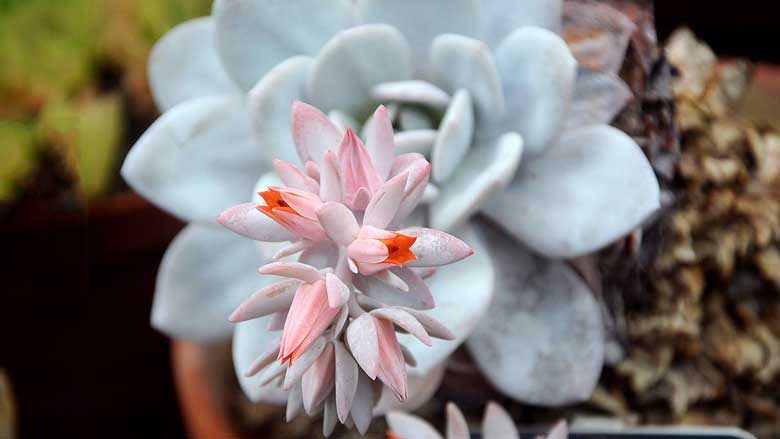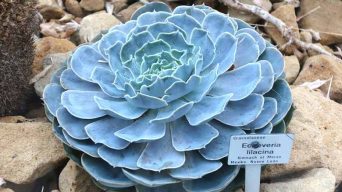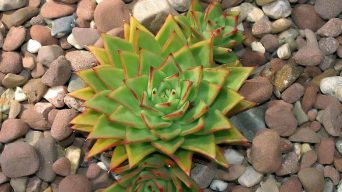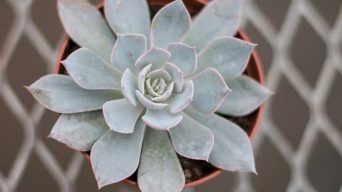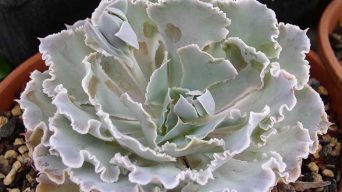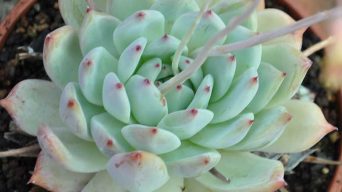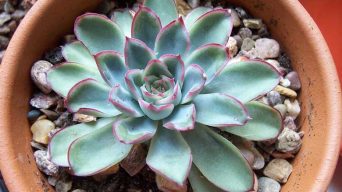Succulents come in various sizes, textures, and colors allowing us to create unique gardens full of variety. One succulent that we find very interesting is the Echeveria Laui.
Echeveria laui is a beautiful, rosette-shaped succulent plant that is relatively easy to grow and propagate.
Growing Echeveria laui at home is fun and easy, even for beginners!
In this guide, we have provided all the necessary information you need to know about taking care of Echeveria laui and how to propagate it.
Echeveria Laui Overview
| Family: | Crassulaceae |
| Genus: | Echeveria |
| Botanical Name: | Echeveria laui |
| Common Names: | La roseta |
| Origin: | Oaxaca, Mexico |
| USDA Hardiness Zones: | 9 to 11 |
| Size: | 6 inches (15 cm) tall and 5 inches (12.5 cm) wide |
| Sun Exposure: | Full sun to partial shade |
| Water Needs: | Water thoroughly but infrequently |
| Soil Type: | Well-draining soil |
| Temperature: | 20-25ºC (68 – 77 ºF) during the day and 15-20ºC (59 – 68 ºF) during the night |
| Humidity Levels: | Low |
Echeveria laui is a slow-growing perennial succulent plant from the Crassulaceae family and indigenous to Mexico.
The Echeveria laui succulent is unbranched, with blue-grey leaves covered with a powdery coating.
The rosettes are up to 6 inches (15 cm) tall and have a diameter of up to 5 inches (12.5 cm).
It blooms from summer to fall; when it does so, you can expect peachy to rose-colored flowers that bloom the entire season.
How To Care for Echeveria Laui
Echeveria laui care is relatively easy and grows well if the plant is properly cared for.
Below you’ll find the essential information you need to know about caring for Echeveria laui.
Sun Exposure & Light Requirements
Echeveria laui is a beautiful succulent that thrives in direct sunlight. It needs approximately six hours of bright, direct sunlight per day.
In the summertime, during intensive months of growth, it will benefit from some shade to avoid overexposure to harsh sun rays, which could cause sunburns and bleaching.
The plant will also do well in partial shade if the exposure is strong enough to sustain growth.
Indoors, place your Echeveria near a west- or east-facing window with plenty of bright light. Avoid intense direct sunlight and provide partial shade if needed.
Watering Requirements
Echeveria laui must be watered more often during the growing season from spring through summer and less so in autumn and winter.
During their active growth period, water your Echeveria once a week, soaking the soil until it becomes completely saturated.
Allow the top 1/2 inch of soil to dry out between waterings. Reduce watering to once every two or three weeks in autumn and winter.
When watering, water directly over the roots, saturating the soil thoroughly. Never allow your Echeveria laui to sit in water, or they may rot.
Avoid wetting the leaves of your Echeveria, as water on these parts can cause rot or fungal infections.
Soil Requirements
Echeveria laui requires a soil mixture that drains well and can retain moisture. You can provide both by using a standard succulent or cactus potting mix combined with perlite and coarse sand.
The right proportion is roughly two parts: soil, perlite, and coarse sand. This should result in a mixture that drains well yet retains some moisture after watering.
Avoid using regular potting soil or any soil that contains vermiculite, peat moss, and other materials that don’t drain well.
Also, avoid using straight sand as it doesn’t retain enough moisture for succulents (and is difficult to wet). Instead, use coarse sand that can be moistened easily.
To prevent the soil from packing down and promote drainage, you can add a thin layer of pumice gravel to the surface of your soil mixture after planting Echeveria Laui.
Temperature and Humidity Requirements
The Echeveria laui succulent plant needs the temperature to stay at 15-20ºC (59 – 68 ºF) during the night and 20-25ºC (68 – 77 ºF) during the day.
If your plant is too warm, it might lose leaves, so be careful. Keep it away from cold drafts, air conditioning, or extreme temperatures.
The Echeveria laui succulent plant grows in dry conditions, so it needs just enough humidity to prevent the leaves from getting crispy.
When the humidity gets too high, your succulent may grow mold or rot.
Fertilizing
Echeveria laui succulent plant is not a heavy feeder but will thrive when fed.
If you want to fertilize your Echeveria, use a very diluted solution (1/8 strength) of fertilizer about 2-3 times during the growing season.
This succulent is sensitive to over-fertilizing, and fertilizer burn could result if too much fertilizer is applied.
Do not fertilize this plant during the autumn and winter because there is less light available; thus, they do not grow much and do not need any feeding.
Potting and Repotting
Echeveria Laui succulent plants must be repotted when the roots start pushing out of the drainage holes or show through the bottom.
You should repot them in a pot slightly larger than its previous one and fill them with potting soil for cacti and succulents.
Repot during spring or early summer and use terracotta or unglazed pots with proper drainage.
When repotting Echeveria plants, remove excess soil from the roots and make sure they aren’t compacted, which can cause rotting and kill your succulents.
Once repotted, don’t water for a week to ensure the roots have dried out and avoid fungal problems.
Pruning
Echeveria laui succulents are slow-growing plants that don’t need to be pruned very often.
However, if you want to maintain the plant’s neat appearance or shape, it is best to trim off any dying or damaged leaves and flowers.
Use sharp scissors for this task, and always cut above a leaf joint because that is where new growth originates.
Pests
Contrary to what one might expect, the Echeveria laui resists most pests, so neglect rarely leads to problems.
However, this does not mean it is free of problems but that the few common problems are relatively easy to deal with.
Some common pests are mealy bugs, aphids, and spider mites.
Mealybugs are tiny white bugs that appear primarily because of humid environments or stagnant air.
You can easily remove them with cotton swabs dipped in alcohol (rubbing or medical) and then be washed away.
Aphids are tiny green or black insects that can appear mostly during warm seasons. They can be removed by a blast from a hose or, in smaller quantities, by soap water.
Spider mites are small red bugs that live in colonies and spin thin webs on the undersides of leaves. They are mostly a problem in dry conditions.
Removing the affected leaves and spraying them with water will be helpful. Still, if the infestation has spread, it is best to quarantine that plant and treat it with a mild soap solution.
Diseases
A few diseases also affect Echeveria, but they are far less common. You can usually prevent them by keeping the soil dry between waterings.
The most common is root rot, which appears when the roots are allowed to stay wet for extended periods.
Another disease that affects Echeveria is powdery mildew, which white spots on the undersides of leaves can identify.
This disease only strikes when there is overcrowding or low air circulation and seems to be caused by excessively humid conditions.
You can prevent both by keeping the soil dry and giving echeveria plenty of space and air circulation.
If Echeveria laui succulent plants appear to suffer from these problems, it is best to quarantine the affected plant and treat them as described above.
How to Care for Echeveria Laui in Winter
Echeveria laui succulents do not cope well with very cold weather.
If you live in an area with no frost, these plants can be grown outdoors throughout the year. Just remember that temperatures at night should be above 60°F (15°C) to avoid damage.
In colder areas, make sure to protect your plant from cold weather as described below:
- Bring your plant indoors before the temperature goes below 40°F (5°C). This way, it will have time to acclimate to the indoor conditions.
- Keep it in a dimly lit spot and at a cool temperature (between 50°F and 55°F if possible).
- Water sparingly, about once every two weeks.
- Reduce any watering when the temperature and light level goes down.
- Move it back outdoors when the weather warms up.
- Stop fertilizing this plant in winter because it does not need fertilizer during this time of year. Fertilizing will probably burn the roots or cause rot due to the cold.
How To Propagate Echeveria Laui
Echeveria laui succulents plants can be propagated by leaf cuttings, offsets, or seeds.
Leaf Cuttings
To propagate Echeveria laui succulents by leaf cuttings, you need to remove a leaf by gently pulling it away from the mother rosette and placing it in an area that receives bright indirect light.
Allow the leaf to callous for a few days before planting it in a new pot with well-draining soil, which can be pre-made succulent or cactus potting soil from the store.
Keep the leaf undisturbed in the new pot until it develops new roots, which may take a few weeks.
Offsets
Offsets are the small rosettes that develop at the base of Echeverias.
To propagate Echeveria laui succulents by offsets, you must pull the offset away from the mother plant and place it in its pot with well-draining soil.
After a few weeks, the offset should have developed enough roots to be transferred to a new pot.
Seeds
You can propagate Echeveria succulents from seeds. They can be grown by anyone with access to the correct type of seed and the ability to keep them in good growing conditions until they germinate.
Echeveria seeds are typically sown on top of soil that is already moist and then left in an area that receives bright indirect light until they germinate.
This can take about two weeks to several months, depending on how healthy the seeds are when they are sown and what conditions they are kept in.
Once the Echeveria laui succulent grows well, you need to transplant it to a new pot with well-draining soil.
Final Thoughts
Growing succulents can be a fun and rewarding hobby.
Echeveria laui is a rare succulent that looks great in any garden or home.
Growing this plant takes little to no effort, making it perfect for beginners.
In addition, propagating the cuttings from Echeveria laui is not tricky, and the results are more than satisfying.
This succulent is a plant that everyone, from casual gardeners to experts, should add to their collection.

